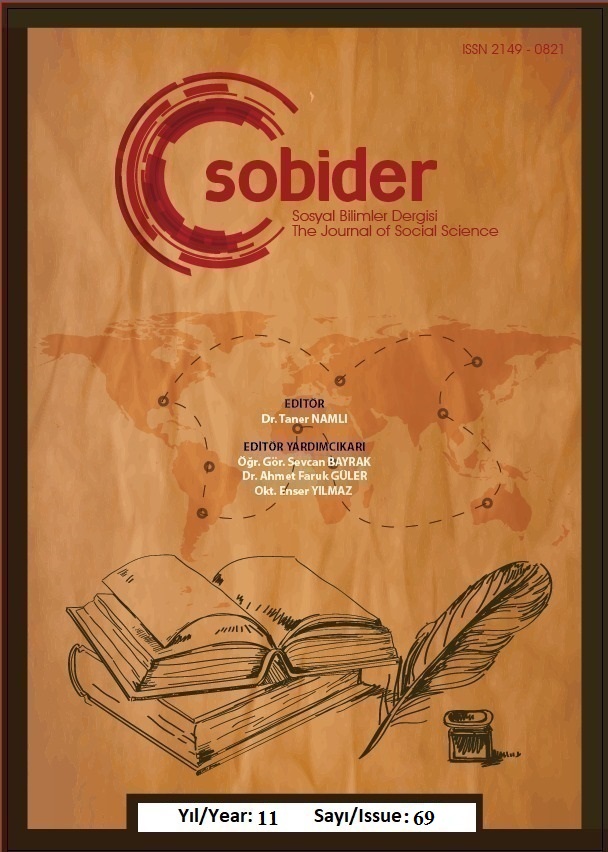YEREL YÖNETİMLERDE İŞ TATMİNİ İLE ÖRGÜTSEL BAĞLILIK İLİŞKİSİ: BELEDİYE ÇALIŞANLARINA YÖNELİK BİR ARAŞTIRMA
Author :
Abstract
Bu çalışmanın amacı iş tatmini ve örgütsel bağlılık arasındaki ilişkinin önemine dikkat çekerek çalışanların performansları bağlamında yaratacağı katkıyı vurgulamaktır. Bu amaçla Ege Bölgesi’nde bulunan bir ilçe belediyesinde görevli çalışanların iş tatmini ve örgütsel bağlılık düzeyleri ile sosyo-demografik özellikleri arasındaki ilişkiler ele alınarak incelenmiştir. Araştırmaya katılan 153 çalışandan elde edilen veriler kapsamında analizler gerçekleştirilmiştir. Bu süreçte öncelikle araştırmanın temel çıkış noktasını oluşturan iş tatmini ve örgütsel bağlılık ölçekleri alt boyutları ile değerlendirilmiştir. Analizler sonucunda çalışanların; dışsal, içsel ve genel iş tatmini düzeyleri ile devam bağlılığı ve normatif bağlılıkları arasında istatistiksel açıdan anlamlı ve pozitif yönde ilişkiler bulunduğu görülmüştür. Buna karşılık duygusal bağlılık düzeyleri ile dışsal, içsel ve genel iş tatmini arasında istatistiksel açıdan anlamlı bir ilişki bulunamamıştır. Bu analizlerin yanı sıra sosyo-demografik özellikler olarak yaş, cinsiyet, medeni durum, eğitim düzeyi, çalışma pozisyonu, hizmet yılı ve aylık gelir değişkenleri ele alınmış, iş tatmini ve örgütsel bağlılık alt boyutları açısından istatistiksel olarak anlamlı düzeyde farklılaşan değişkenler belirlenmiştir. Buna göre çalışanların dışsal, içsel ve genel iş tatmini boyutlarından aldıkları puanların yaş, öğrenim durumu ve çalışma pozisyonu değişkenleri kapsamında anlamlı derecede farklılaştığı saptanmıştır. Çalışanların örgütsel bağlılık alt boyutlarından aldıkları puanların değerlendirilmesi sonucunda ise hizmet yılı ve gelir düzeyleri açısından devam bağlılığı boyutunda anlamlı farklılıklar olduğu belirlenmiştir.
Keywords
Abstract
The purpose of this study is to draw attention to the importance of the relationship between job satisfaction and organizational commitment and to emphasize its contribution to the performance of employees. For this purpose, the relationship between job satisfaction and organizational commitment levels of employees working in a district municipality in the Aegean Region and their socio-demographic characteristics were examined. Analyses were carried out within the scope of the data obtained from 153 employees participating in the research. In this process, job satisfaction and organizational commitment scales, which constitute the main starting point of the research, were evaluated with their sub-dimensions. As a result of the analyses, statistically significant and positive relationships were found between employees' extrinsic, intrinsic and general job satisfaction levels and their continuance commitment and normative commitment. On the other hand, no statistically significant relationship was found between emotional commitment levels and extrinsic, intrinsic and general job satisfaction. In addition to these analyses, age, gender, marital status, education level, working position, years of service and monthly income variables were considered as socio-demographic characteristics, and statistically significant variables were determined in terms of job satisfaction and organizational commitment sub-dimensions. Accordingly, it was found that the scores of the employees in terms of extrinsic, intrinsic and general job satisfaction dimensions differed significantly within the scope of age, education level and working position variables. As a result of the evaluation of the scores obtained by the employees from the organizational commitment sub-dimensions, it was determined that there were significant differences in the continuance commitment dimension in terms of years of service and income levels.





